
Posted on 06/09/2012 5:10:18 AM PDT by Homer_J_Simpson

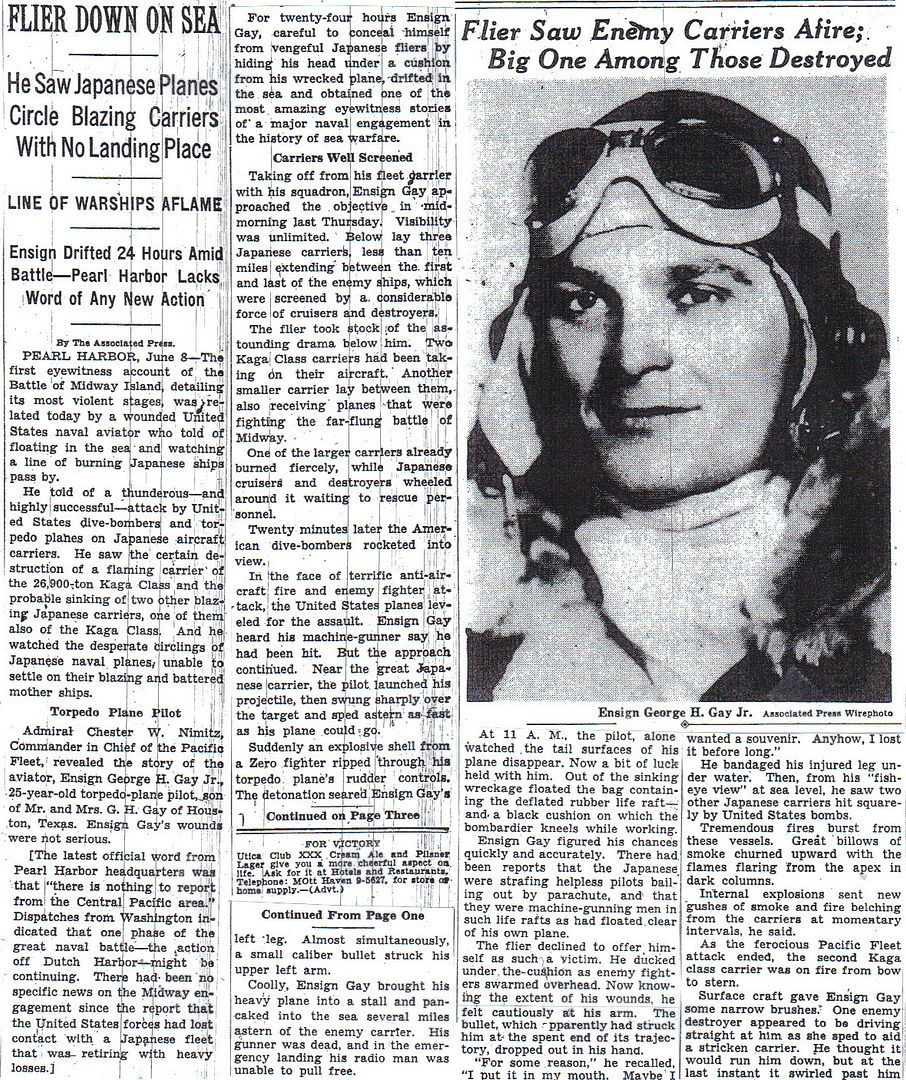
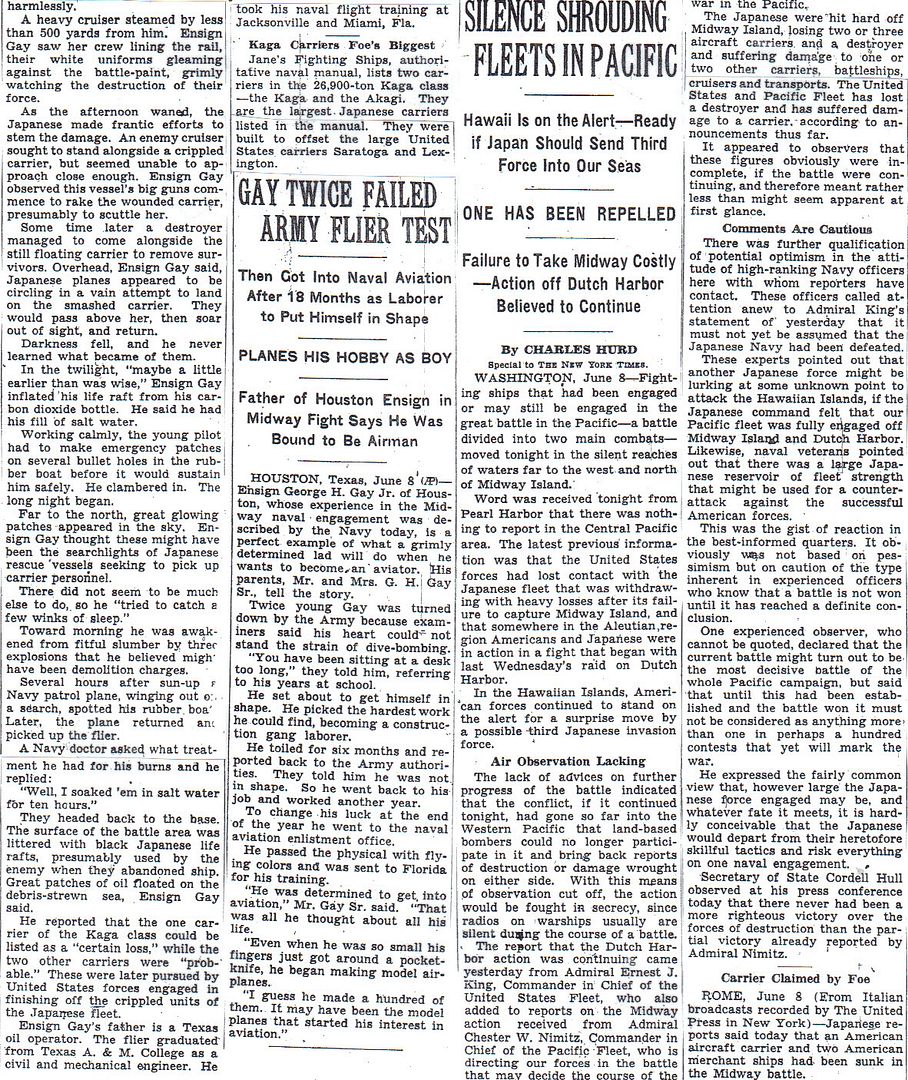
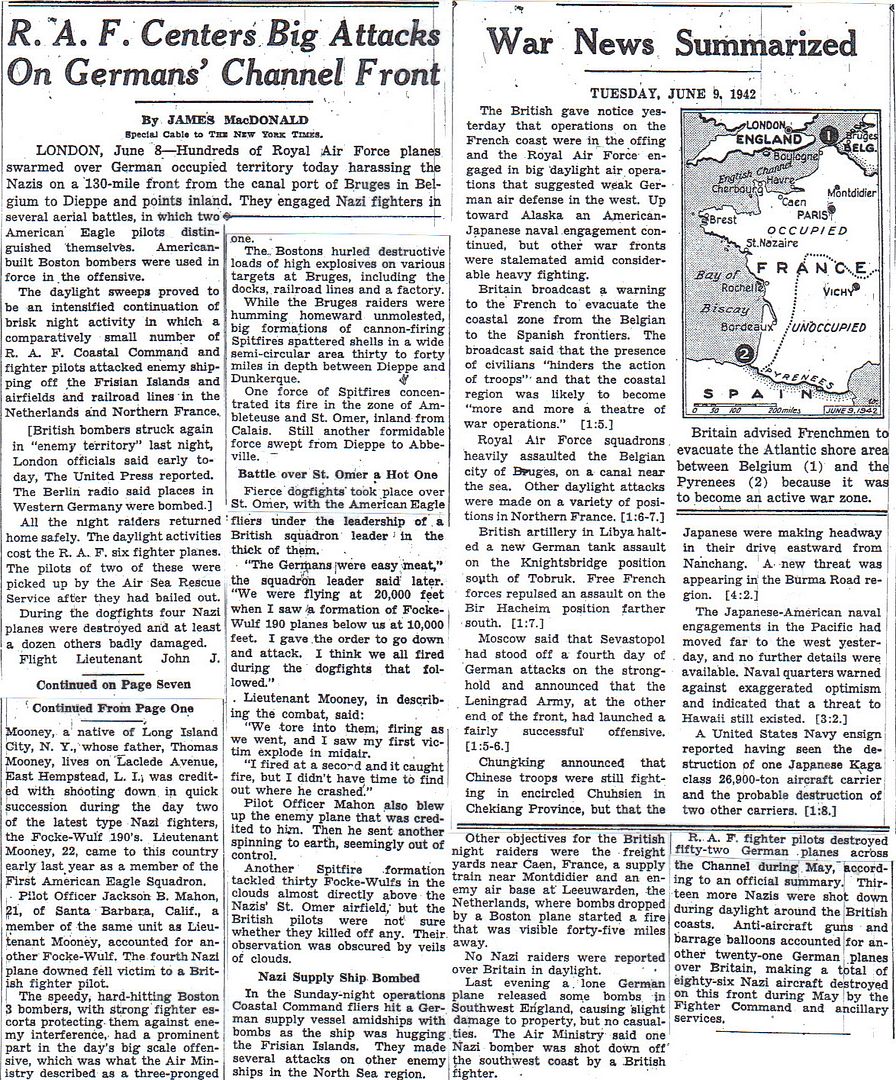

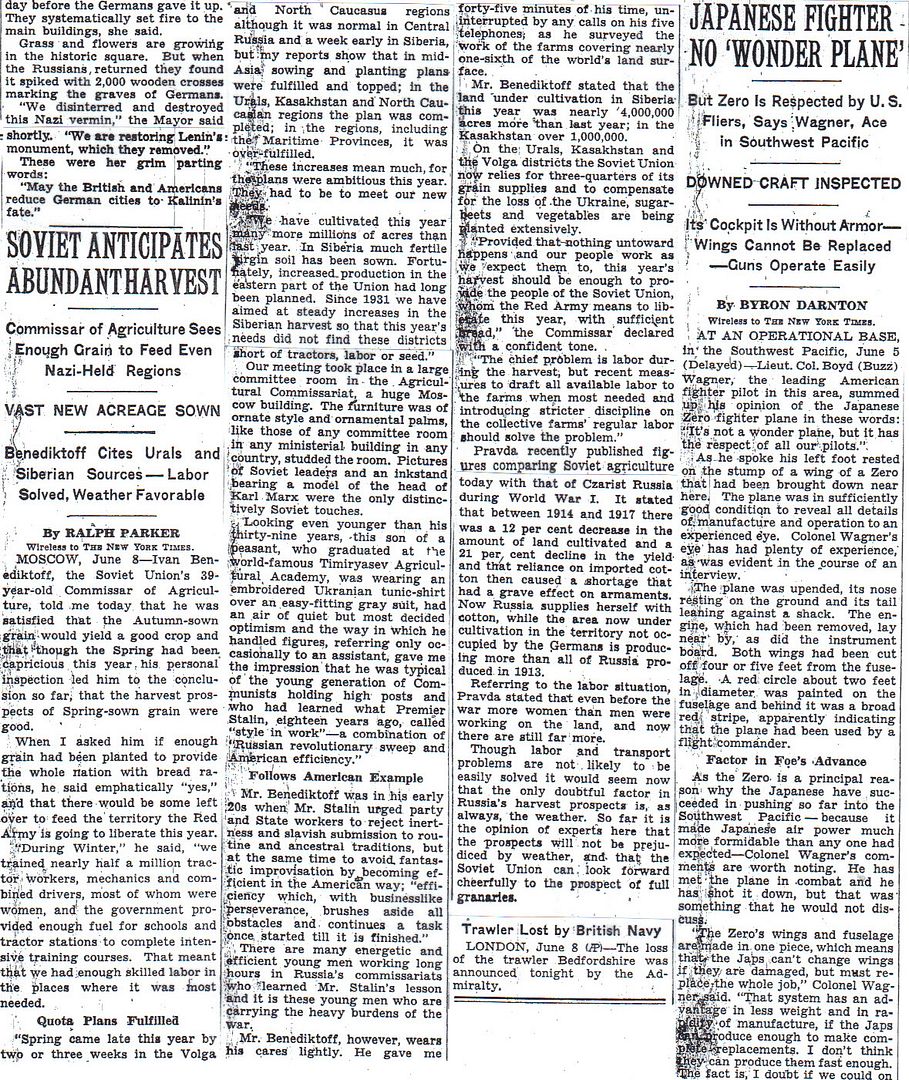
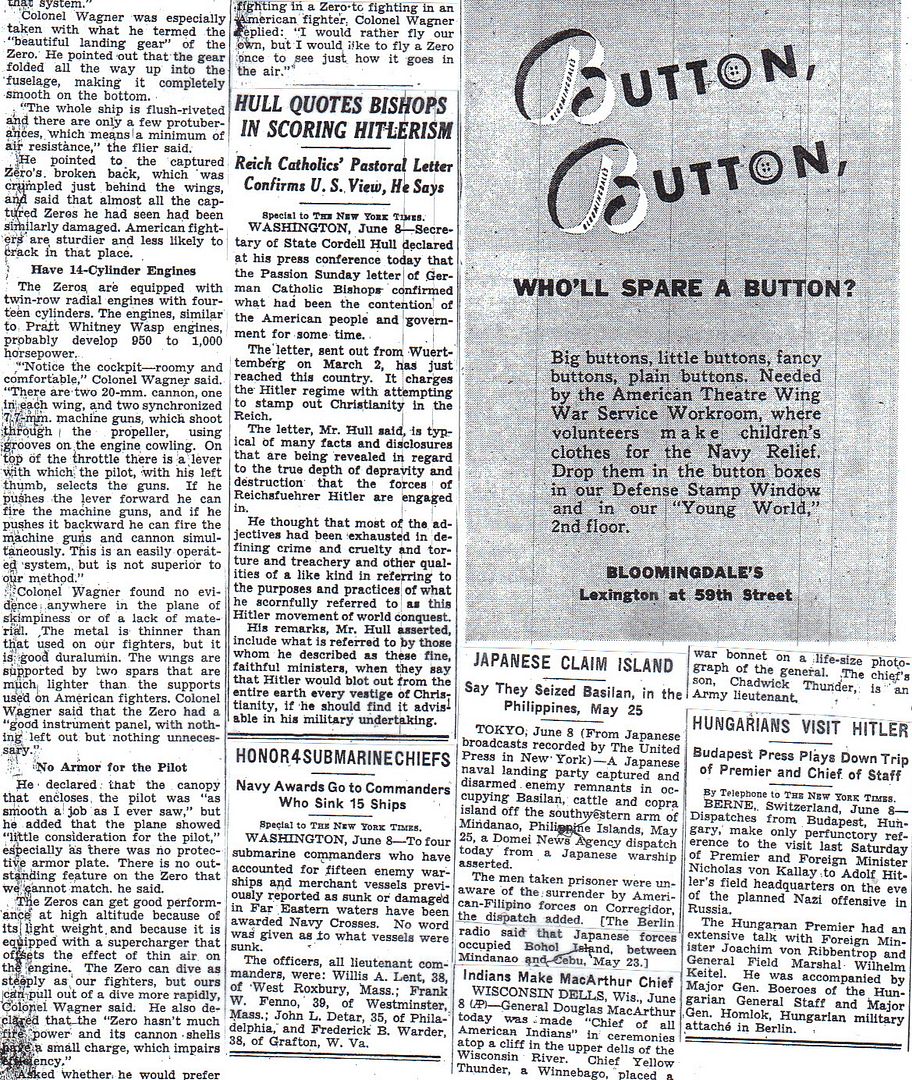
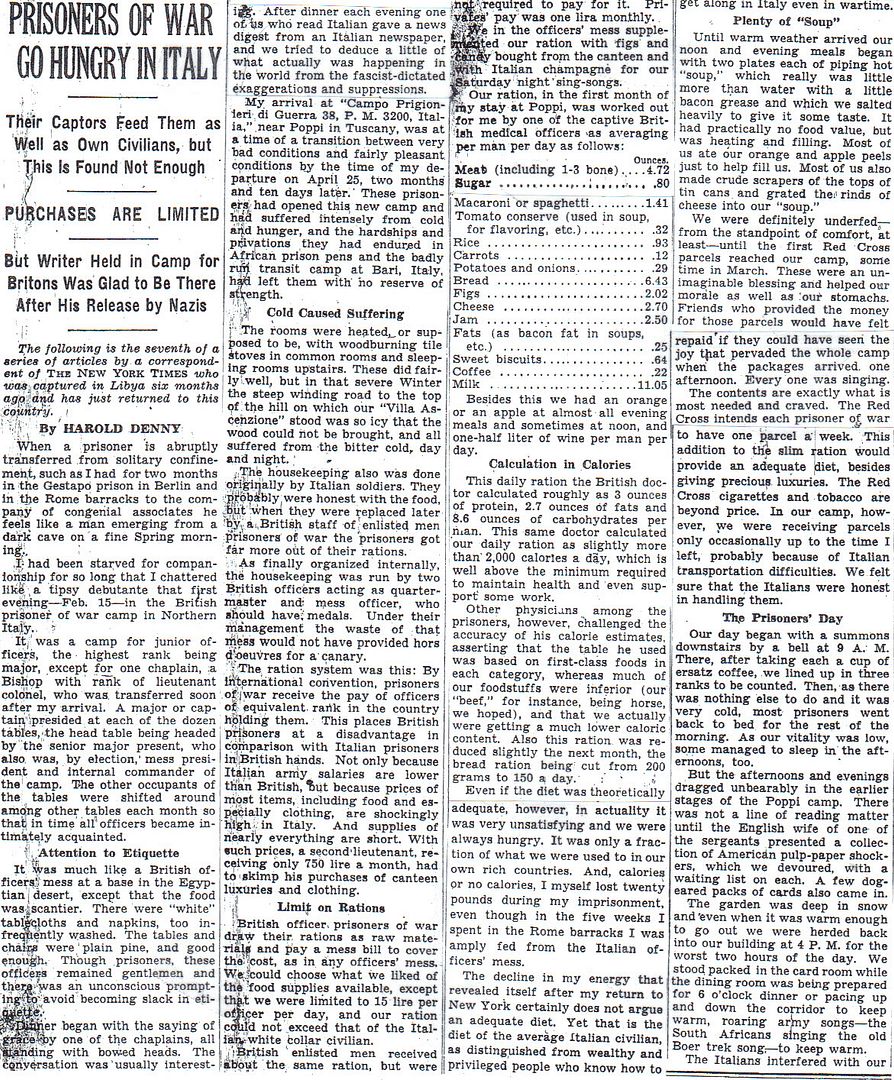
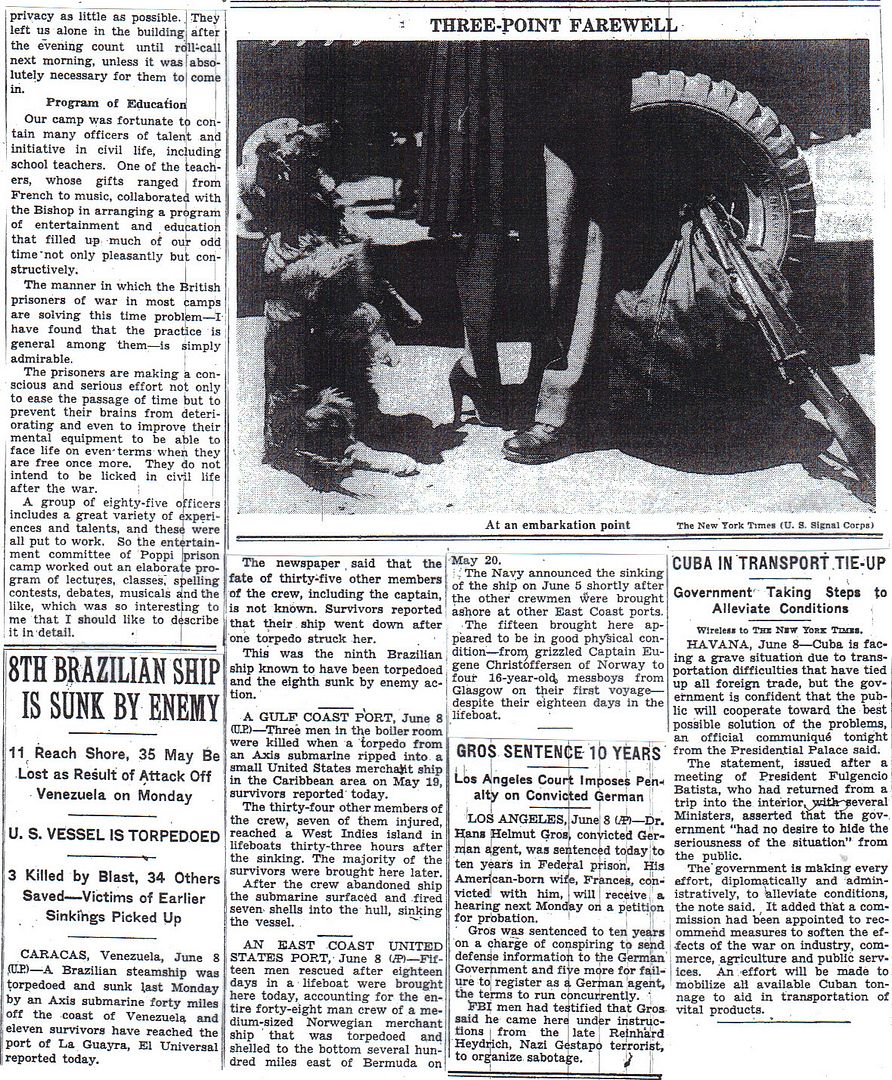
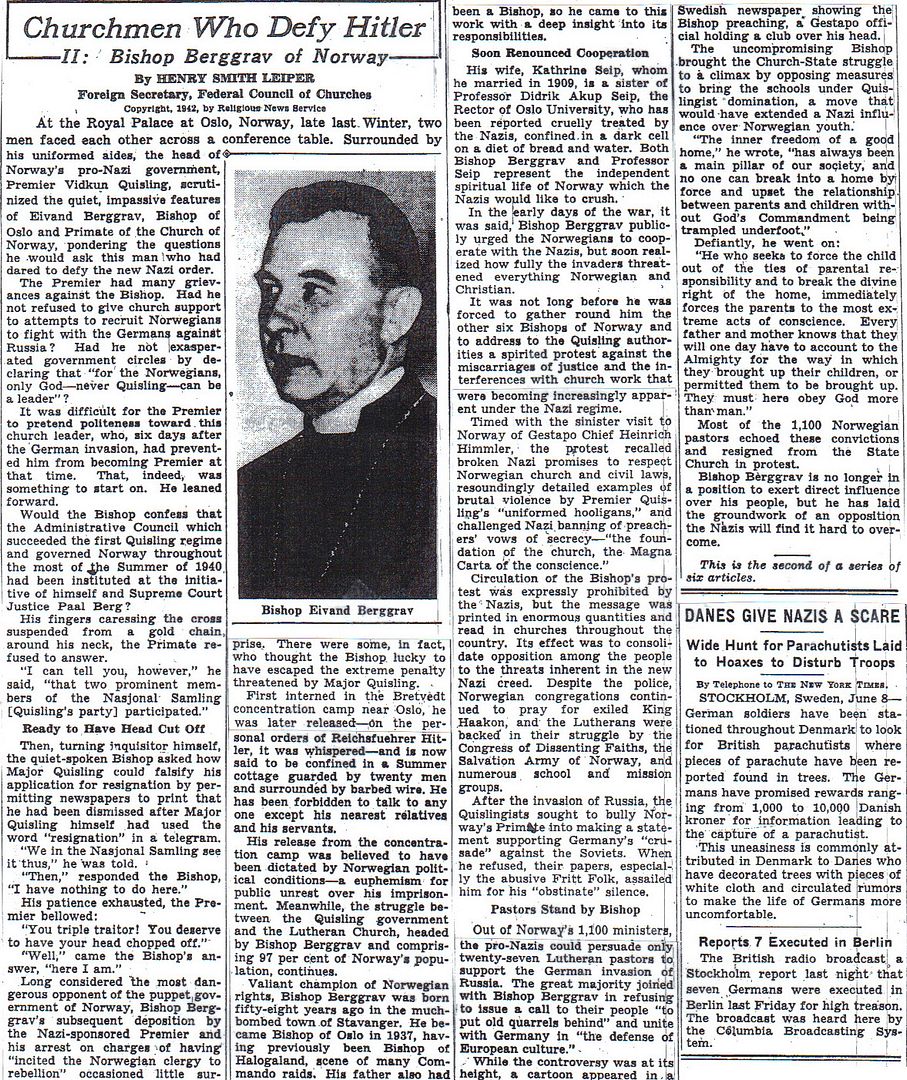
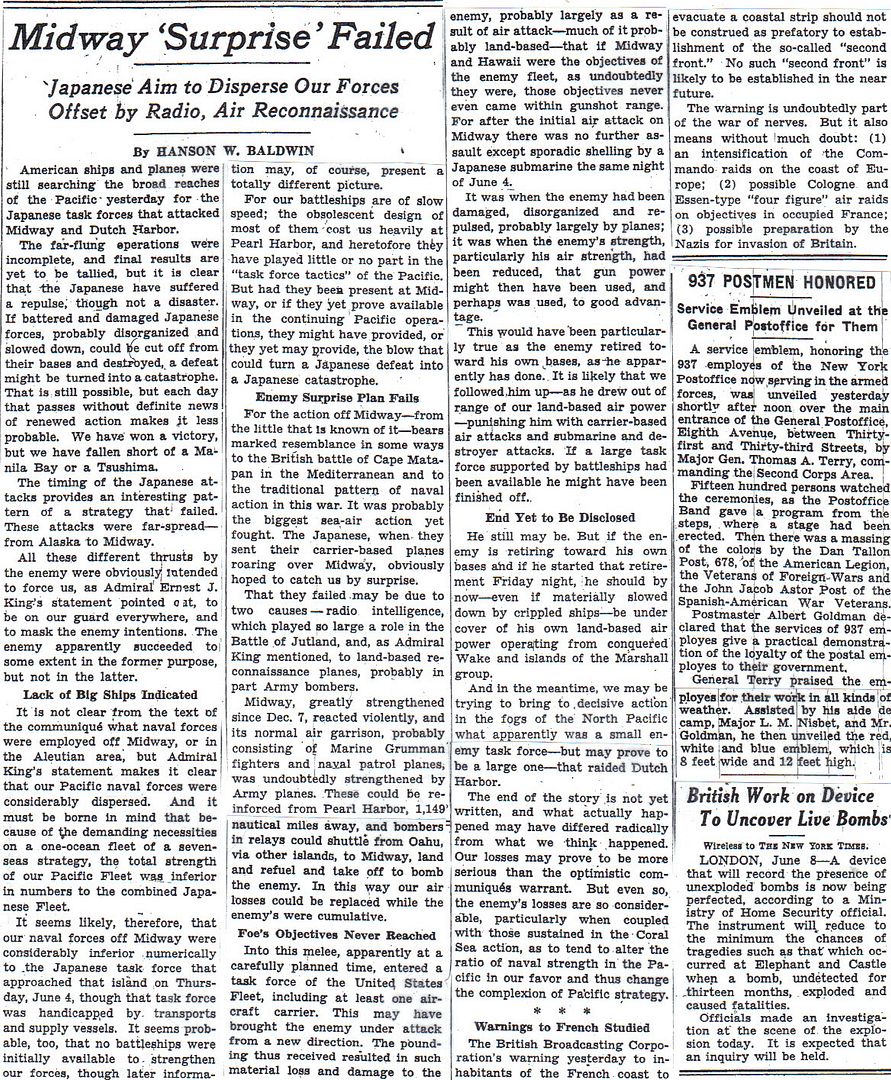
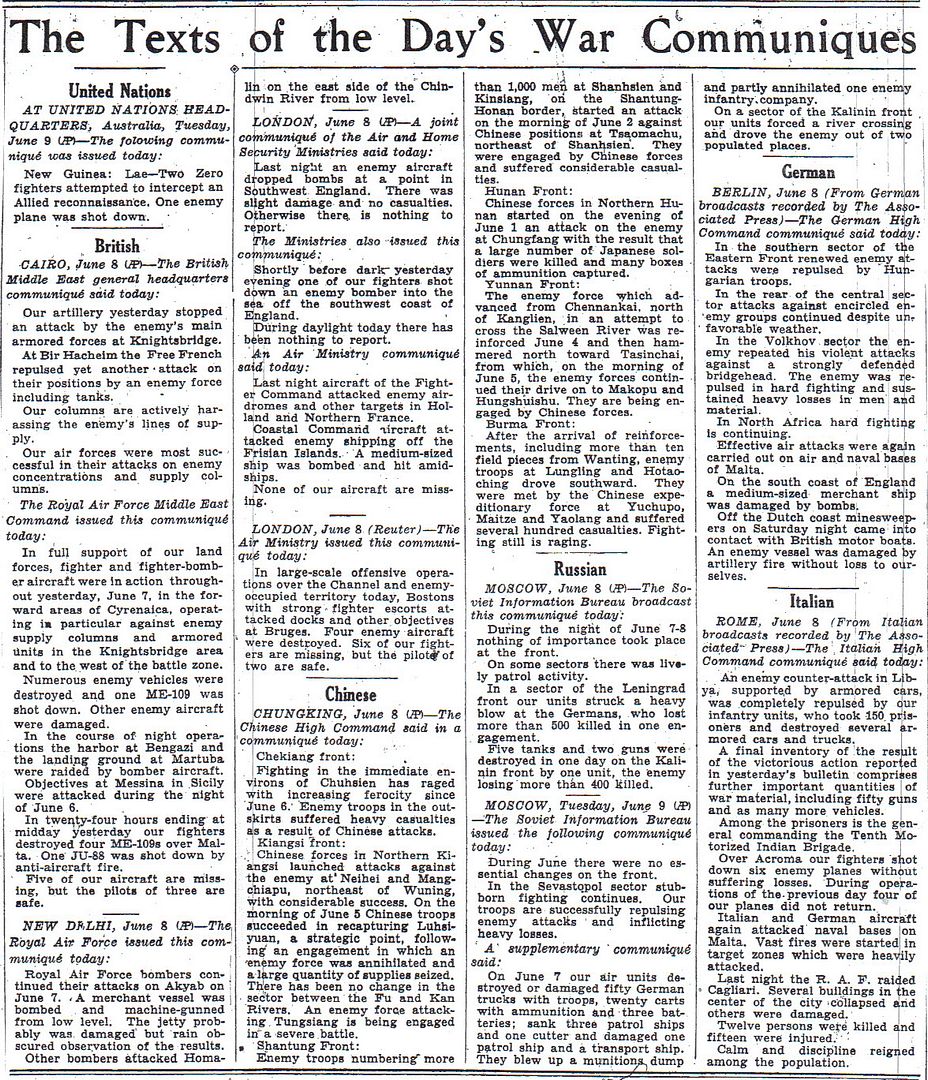
That was the only Gay we had in the military back then.

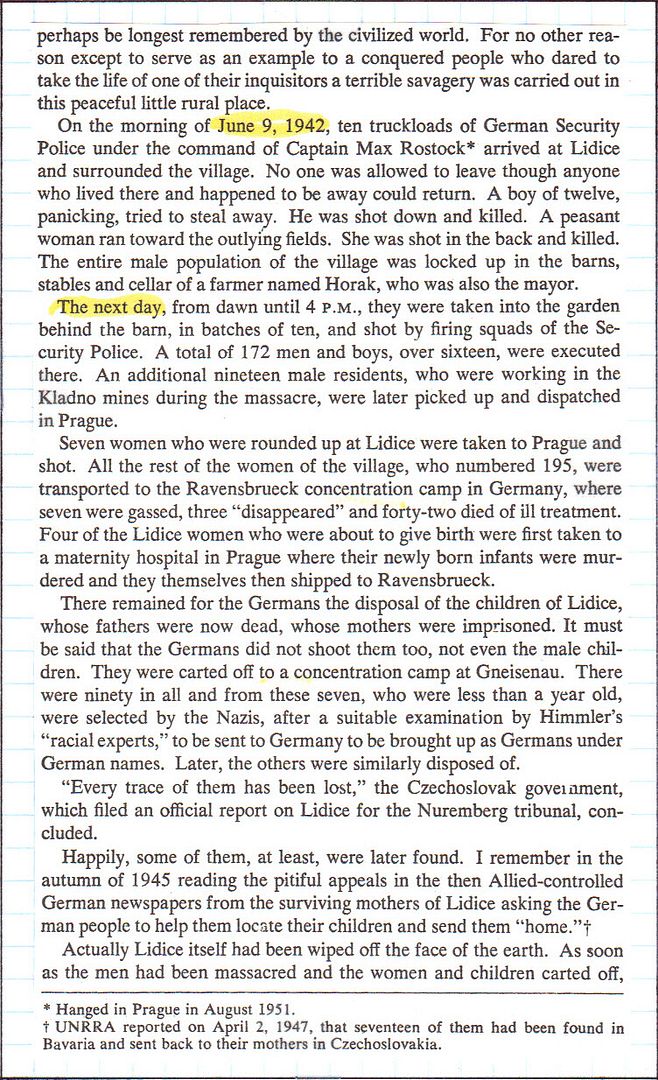
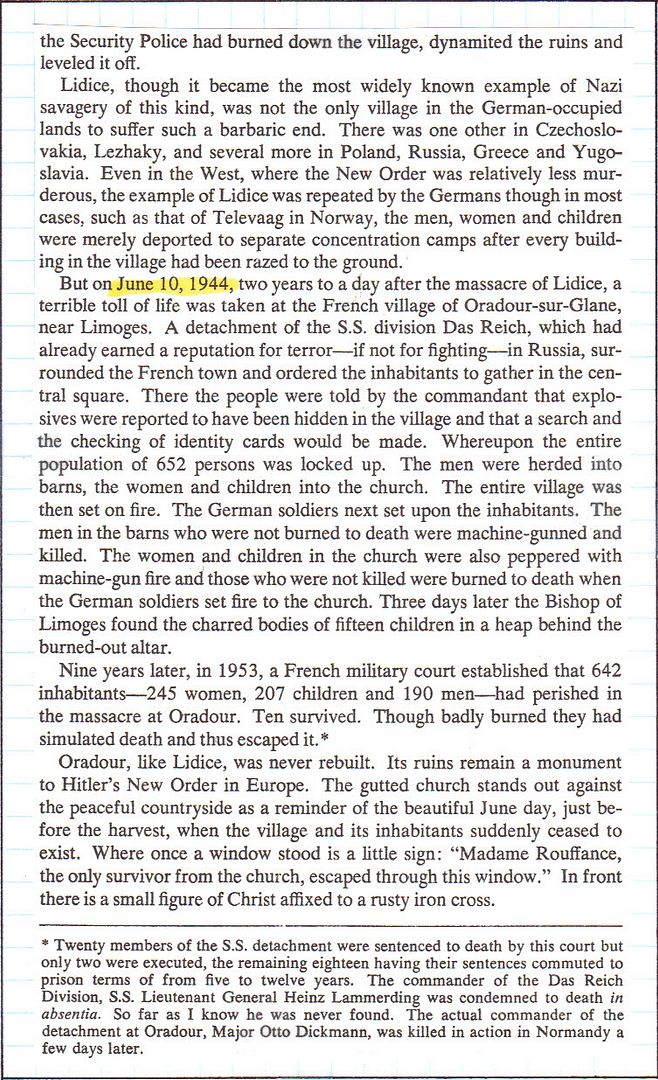
William L. Shirer, The Rise and Fall of the Third Reich
Flier Down on Sea – 2-3
Silence Shrouding Fleets in Pacific (Hurd) – 3
R.A.F. Centers Big Attacks on Germans’ Channel Front (MacDonald) – 4
War News Summarized – 4
British Guns Halt Nazi Push in Libya (Levy) – 5
Sevastopol Bars Foe for 4th Day; Nazi Losses High, Attack Goes On – 5-6
Soviet Anticipates Abundant Harvest (Parker) – 6
Japanese Fighter No ‘Wonder Plane’ (Darnton) – 6-7
Prisoners of War Go Hungry in Italy (Denny) – 8-9
Churchmen Who Defy Hitler-II: Bishop Berggrav of Norway (by Henry Smith Leiper) – 10
Midway ‘Surprise’ Failed (by Hanson W. Baldwin) – 11
The Texts of the Day’s War Communiques – 12
http://www.onwar.com/chrono/1942/jun42/f09jun42.htm
Nazis massacre population of Lidice
Tuesday, June 9, 1942 www.onwar.com
Bodies Czech civilians killed in Lidice [photo at link]
In Occupied Czechoslovakia... In reprisal for the assassination of Heydrich (on May 27th), the German authorities level the village of Lidice and kill its population. More than 100 Czechs have already been executed in retribution for the assassination.
In the Mediterranean... The air bombardment of Malta continues. An additional 32 Spitfires are flown to Malta to replace losses.
From Washington... The British and Americans appoint Oliver Lyttleton and Donald Nelson as heads of the Combined Boards for Production and Food.
http://homepage.ntlworld.com/andrew.etherington/frame.htm
June 9th, 1942
CZECHOSLOVAKIA: Protectorate of Bohemia and Moravia: The entire town of Lidice is destroyed in reprisal for the assassination of Heydrich on May 27.
A few children survived the massacre and were SOLD to German families at RM 50 each. This was one of many reprisal actions for the recent assassination of Reinhard Tristan Eugen Heydrich in Prague.
Thirty-five prisoners were trucked in the next morning from nearby Theresienstadt camp to clean up, bury the dead.
Lidice became an international symbol for Nazi tyranny - although hundreds of similar villages were likewise destroyed in Belarus and other German occupied territory. (John Nicholas and Tom Hickcox)
U.S.S.R.: Germany launches a new offensive on the Kharkov front.
MALTA: A consignment of 32 Spitfires is delivered by the carrier HMS EAGLE.
MADAGASCAR: HMS Ramillies leaves Diego Suarez today, bound for Durban for structural repairs. Her escort on the journey was by the light Cruiser HMS Emerald, three destroyers and a tug. There was much apprehension about the journey due to the extensive damage she had taken, from the Japanese midget submarine attack, and worry about the gaping hole in her side. She arrives at Durban late today having been escorted for the latter part of her journey by HMS Jasmine and HMS Fritillary.
She will leave for Cape Town and the UK on the 6th August 1942 arriving back at Plymouth on the 8th September for further repairs at the Devonport Dockyard. She will be out of service for nearly a year (Denis Peck)
JAPAN: The Japanese declare that the Philippine Islands are secured. (Jack McKillop)
AUSTRALIA: Lieutenant Commander Lyndon B. Johnson, USNR, on a congressional inspection tour of the Southwest Pacific, boards a B-26 Marauder, msn 1353, USAAC s/n 40-1488, flown by 1st Lt. W. H. Greer as pilot and RAAF Sergeant Pilot G. A. McMullin as co-pilot, of the USAAF’s 19th Bombardment Squadron (Medium), 22d Bombardment Group (Medium) based at Townsville, Australia, to participate in an attack on Japanese airfields in New Guinea. The aircraft takes off but engine trouble forces the pilot to return to base without having seen combat. For this mission, Johnson is awarded the Silver Star for “gallantry.” Johnson goes on to become the 36th President of the U.S.
Here is the story of the mission.
Eleven B-26 Marauder’s of the 22nd Bombardment Group (Medium) departed Townsville, Queensland, Australia, at 1330 hours local on 8 June 1942 and arrived at Seven Mile Aerodrome, Port Moresby, New Guinea, by 1746 hours local. They then raided Lae, New Guinea, on 9 June 1942. This mission was called “TOW 9” in the official records.
Lieutenant Commander Lyndon Baines Johnson, USNR, the future 36th President of the United States, went on this raid as an observer.
Lyndon Johnson travelled from Townsville to Port Moresby by B-17 on the morning of the raid.
The raid was delayed by an hour waiting for the VIP’s that were to accompany them on the raid. The VIP’s were Congressman Lyndon Baines Johnson (USNR), General Marquat, Col. G. Anderson (Gen Staff), Lt Col. Dwight Divine II and Lt. Col. Francis R. Stevens.
Lyndon Johnson was initially assigned to Lt. Bench’s aircraft, “The Virginian,” USAAC 40-1508. But he apparently left the aircraft to retrieve his camera and on return he found that Lt. Col. Francis R. Stevens had taken his place on “The Virginian.” Lyndon Johnson then changed aircraft from “The Virginian” to Arkie Greer’s “Heckling Hare” just before he took off on the mission. The crew of “Heckling Hare” apparently also knew their aircraft as “Arkansas Traveller.”
This was fortuitous for Lyndon Johnson, as Bench’s aircraft, “The Virginian,” was boxed in so low by “Shamrock,” Thunderbird” and “Boomerang” as they departed the target, that “The Virginian” flew into the water off Salamaua killing Willis Bench and all of his crew.
After the mission, Lyndon Johnson returned to Australia in General Brett’s Boeing B-17D Flying Fortress, USAAC 40-3097 “Swoose” flown by Captain Frank Kurtz. They almost ran out of fuel when they became lost heading for Cloncurry, Queensland. They landed in the bush on Carisbrooke Station near Winton. This B-17, “Swoose”, then flew back to USA with General Brett. The aircraft is owned by the National Air and Space Museum in Washington.
Nine days after the raid, Lyndon Johnson was awarded an Amy Silver Star medal, the nation’s 3rd highest medal for valour, by General MacArthur’s chief of Staff, Major-General R.K. Sutherland for his participation in the above bombing raid. He often wore this medal during his term as President of the United States. He refused to discuss the details of how we won the medal. His citation read:-
“For gallantry in action in the vicinity of Port Moresby and Salamaua, New Guinea on June 9, 1942. While on a mission of obtaining information in the Southwest Pacific area, Lieutenant Commander Johnson, in order to obtain personal knowledge of combat conditions, volunteered as an observer on a hazardous aerial combat mission over hostile positions in New Guinea. As our planes neared the target area they were intercepted by eight hostile fighters. When, at this time, the plane in which Lieutenant Commander Johnson was an observer, developed mechanical trouble and was forced to turn back alone, presenting a favorable target to the enemy fighters, he evidenced marked coolness in spite of the hazards involved. His gallant action enabled him to obtain and return with valuable information.”
Lyndon Johnson’s diary records the following regarding this mission:-
“After we were off the field with Prell and Greer leading, Greer’s generator went out: crew begged him to go on. For the next thirty minutes we flew on one generator.”
(Jack McKillop)
CANADA: Lt Denis James Patrick RCNVR awarded Bar to George Medal.
Harbour craft HMC HC 181, 161, 155, 162, 170 and 177 are ordered from SG Mason Tancoak in Nova Scotia.
Harbour craft HMC HC 151, 152, 153, 197, 154 and 169 are ordered from Palmer and Williams Summerside in Prince Edward Island. (Dave Shirlaw)
U.S.A.: A German submarine sinks an armed U.S. freighter in the Caribbean, 60 miles (96.6 km) off the Honduran coast. (Jack McKillop)
First US Navy photographic interpretation unit set up in the Atlantic. (Dave Shirlaw)
Radio News, with mention of Ensign George Gay:
http://ia601200.us.archive.org/0/items/1942RadioNews/1942-06-09-CBS-News-of-the-World-AM-Edition.mp3
If this had happened under the current regime, they would have reported how victory at Midway had been brought about by Obama personally cracking the Japanese code.
"Jews of Kraków, Poland, were ordered to clean out the homes of their brethren, who had recently been deported from the ghetto.
The first round of deportations began at the end of May 1942 and continued until June 8.
During the first wave of roundups, 6,000 Jews were deported to the Belzec death camp and 300 were murdered on the spot.
A second Aktion took place on October 27-28; 7,000 Jews were deported and 600 were killed."
"Appointed president of the Vichy Republic in 1942, Pierre Laval immediately became a willing tool of the Nazis.
He approved and facilitated German efforts to round up and deport Jewish émigrés, including children.
Laval expedited the deportation process by ordering French police to cooperate with Nazi authorities, sending some 25,000 Jews to the ghettos and concentration camps of the East during the summer months."
Thanks, PWK. This report covers the war all around the world. There are reports from the eastern front, Libya, the British Isles, Australia, and Washington, in addition to Ensign Gay's story. Very interesting.
In terms production worker compensation, $50 per month in 1942 was worth about $1,600 per month today -- and that was all "spending money".
But in terms of the national effort needed to pay the troops $50 per month, it equates to about $4,700 per month today.
"WE'RE ready to cast off, Herr Generaloberst."
The Italian naval lieutenant saluted. Manstein touched his cap, nodded with a smile, and turned to his entourage: "All right, then, gentlemen, let's board our cruiser."
The cruiser was an Italian motor torpedo-boat, the only naval unit available to Manstein. Captain Joachim von Wedel, the Harbor Commandant of Yalta, had somehow got hold of it. Manstein wanted, on that 3rd June 1942, to sail along the southern coast of the Crimea to establish for himself whether the coastal road was under observation from the sea. It was along this road that all supplies for XXX Corps, which was holding the southern front of Sevastopol under General Fretter-Pico, had to be moved. Any threat to these supplies by Soviet naval units might have upset the programme for the battle of Sevastopol.
In brilliant sunshine the boat streaked along the Black Sea coast. The gardens of Yalta with their tall trees provided a beautiful setting for the white country houses and palaces. The boat held to a westerly course until it was off Balaclava. The ancient fort on the bare, rocky hilltop towered into the blue sky with its two massive bastions.
The bay which cut into the shore at the foot of the rock was an iridescent blue. This was where in 1854-55, during the Crimean War, French, British, Turks, and Piedmontese, having landed at Yevpatoriya, fought their unending battle to bend the Tsar Nicholas to their will. The siege and battle of Sevastopol had gone on for nearly a year—347 days to be exact—before the Russians surrendered. The number of casualties, including civilians, had been very high for those days. Estimates vary between 100,000 and 500,000. Colonel-General von Manstein was acquainted with all these facts. He had read all the literature about the Crimean War. He also knew that under the ancient forts the Soviets had built entirely new modern defenses—huge casemates, reinforced concrete gun emplacements with armored cupolas, and a labyrinth of underground supply stores. There was no doubt that in 1942 Stalin would defend this naval fortress every bit as stubbornly as Tsar Nicholas I had done in 1854-55.
Sevastopol with its favorable natural port was the main base of the Soviet Navy in the Black Sea. If it fell the Soviets would have to withdraw to some hide-outs on the eastern coast. Manstein and Captain von Wedel were engrossed in conversation when the boat was suddenly shaken by a crashing, splintering noise.
"Enemy aircraft," shouted Manstein's orderly, First Lieutenant Specht.
The Italians racing to their anti-aircraft machine-gun were too late. Out of the sun two Soviet fighters from Sevastopol had pounced down on the boat and shot it up with their cannon.
The deck had been ripped open, and fire was beginning to spread. Captain von Wedel, who had been sitting next to Manstein, collapsed—dead. The Italian mate was slumped over the rail—also dead. Fritz Nagel, Manstein's faithful companion in every battle since the first day of the war, had been flung against the after ventilation shaft with a severe thigh wound. His artery had been severed. Blood was gushing out of his wound in quick spurts. The Italian commander tore off his shirt to tie up Nagel's artery. Lieutenant Specht threw off his clothes, dived into the sea, and swam to the coast. Stark naked, he stopped a surprised lorry driver and made him race to Yalta. There the lieutenant grabbed a motor-launch, raced back to the blazing motor torpedo boat, and towed her back into Yalta harbor.
Manstein himself took Nagel to the military hospital. But it was too late. The sergeant was beyond help.
Two days later, when all round Sevastopol the squadrons of General Richthofen's VII Air Corps were starting up their engines for the first act of the great battle, Manstein stood despondently at the open grave of his driver in the cemetery of Yalta. The words spoken by the Colonel-General over the coffin of his sergeant are worthy of record in this otherwise so dreadful chronicle of this most frightful war in human history:
"Over the years during which we shared both the daily routine and major events we became friends.
This bond of friendship cannot be severed even by the vicious bullet which struck you.
My gratitude and loyal affection, the thoughts of all of us,
accompany you beyond the grave into eternity.
Rest in peace and farewell, my best comrade."
The rifle salvo rang out over the tree-tops. From the west came a sound like distant thunder: Richthofen's squadrons had gone into action against Sevastopol. The great twenty-seven-day battle against the world's strongest fortress had begun.
From the rocky hilltop there was a magnificent view of the entire area of Sevastopol. Sappers had blasted an observation post into the rock-face, reasonably secure against enemy artillery and aircraft. From there the entire town and fortified area could be surveyed by stereo-telescope as if from a viewing platform. At this observation post Manstein spent hour after hour with his chief of operations, Colonel Busse, and his orderly officer, "Pepo" Specht, observing the effect of the Luftwaffe's and artillery's bombardment. The date was 3rd June 1942.
At the spot where the ancient Greeks had established their first trading-post, where the Goths had built their hilltop castles during the great upheavals of the early centuries of the Christian era, where Genoese and Tartars had fought for the harbors and fertile valleys, and where in the nineteenth century rivers of British, French, and Russian blood had been shed, a German general was now sitting, pressed close to the rock, once more directing a battle for the harbors and bays of the Crimea, that idyllic peninsula in the Black Sea.
"Fantastic fireworks," Specht remarked.
Busse nodded. But he was skeptical.
"Even so I'm not sure that we'll punch sufficiently large holes into those fortifications for an infantry attack."
Manstein was standing by the trench telescope, gazing across to the Belbek Valley with its prominent peak which the troopers had named the Mount of Olives. Squadrons of Stukas were roaring overhead. They dived down on Sevastopol. They dropped their bombs and fired their cannon and machine-guns. Then they turned away again. Ground-attack aircraft skimmed over the plateau. Fighters tore across the sky at great height. Bombers droned along steadily. The Eleventh Army had unchallenged control of the air within a few hours of the beginning of the bombardment. The weak Soviet Air Force of the coastal Army had been smashed. It had gone into the battle with only fifty-three aircraft. General von Richthofen's VIII Air Corps flew 1000, 1500, and even 2000 missions a day. "Continuous attack" was the Air Force experts' term for this conveyor-belt type of raid. And while a rain of bombs fell on Sevastopol from the sky, German guns of all calibers were pumping their shells into the enemy positions.
The artillerymen sought out the enemy gun emplacements. They leveled trenches and wire obstacles. They sent shell after shell against the firing-slits and armored cupolas of concrete gun positions. They fired their guns day and night—throughout five times twenty-four hours.
This was Manstein's idea of a really decisive overture to the attack—not, as usual, just one or two hours' concentrated artillery and Luftwaffe bombardment, followed by an infantry charge. Manstein knew that a conventional preliminary bombardment would be ineffective against Sevastopol's massive defenses with their hundreds of concreted and armor-plated gun emplacements, the deep belt of pill boxes, the powerful armored batteries, the three defensive strips with their total of 220 miles of trenches, the extensive wire obstacles and minefields, and the rocket cannon and rocket mortars mounted in positions hewn out of the cliff-face.
That was why Manstein's plan provided for five days of massive annihilating fire by artillery, mortars, anti-aircraft guns, and assault guns. Altogether 1300 barrels hurled their missiles against the identified fortification works and field positions of the Soviets. To that must be added the bombs dropped by the squadrons of VIII Air Corps. The earth was covered with a hail of steel. It was a murderous overture.
Never during the Second World War, neither before Sevastopol nor after it, were such massed artillery forces employed by the Germans.
In North Africa at the end of October 1942 Montgomery opened the British offensive against Rommel's positions at El Alamein with his now historic 1000 barrels. Manstein employed 300 more at Sevastopol.
À particular role in the artillery bombardment was played by the mortars. This eerie weapon was here for the first time employed in heavy concentration. Two mortar regiments—the 1st Heavy Mortar Regiment and the 70th Mortar Regiment — as well as the 1st and 4th Mortar Battalions, had been concentrated in front of the fortress under the special command of Colonel Niemann—altogether twenty-one batteries with 576 barrels, including the batteries of 1st Heavy Mortar Regiment with their 11- and 12-1/2 inch high-explosive and incendiary oil shells, which were particularly effective against fortifications.
Each second the bombardment lasted the barrels of this regiment alone spewed forth 324 mortar bombs against strictly limited sectors of the enemy's field fortifications. The effect on the Russians' morale was as destructive as the bombs' physical effects. The effect of thirty-six monstrous missiles with fiery tails whooshing from one single battery and slamming with a nerve-racking whine into an enemy position was unimaginable. The fragmentation effect of a single mortar bomb was not as great as that of an artillery shell, but the blast of several of them exploding close to one another ruptured the troops' blood vessels. Even the men lying a short distance away from the point of impact were demoralized by the deafening noise and paralyzing high pressure of the explosion. Terror and fear grew into panic. Only Stukas had been known to produce a similar effect on the usually so impassive Russians. It is only fair to say that, faced with concentrated fire from Russian rocket mortars, "Stalin's organ pipes," the German troops were often similarly gripped by fear and terror.
Among the conventional artillery battering against the doors of the fortress of Sevastopol there were three special giants which have gone down in military history—the Gamma mortar, the mortar "Karl" (also known as "Thor"), and the railway gun "Dora."
These three miracles of modern engineering, the last word, as it were, in conventional artillery development, had been specially built for employment against fortresses. Before the war the only fortresses in existence, apart from those in Belgium and the French Maginot Line, were Brest Litovsk, Lomsha, Kronshtadt, and Sevastopol. Leningrad was no longer a fortress in the true meaning of the word, and the ancient French fortress towns along the Atlantic coast had long since ceased to count. The Gamma mortar was a revival of "Big Bertha" of the First World War. Its 16.8-inch projectiles weighed 923 kg.—nearly a ton—and could be hurled at targets nearly 9 miles away. The length of its barrel was twenty-two feet. This unusual giant was serviced by 235 artillery men. But "Gamma" was a pigmy compared with the 24.2-inch mortar known as "Karl" or "Thor"—one of the heaviest pieces of the Second World War and a special Army weapon against the most powerful concrete fortresses. Its 2200-kg. (2.4-tons) concrete-piercing bombs, which shattered the strongest concrete roofs, were hurled by a monster which barely resembled a conventional mortar at all. Its relatively short barrel of a little over sixteen feet and its colossal carriage and bogies made it look rather like some factory with an eerie stub of a smokestack.
But even "Karl" was not quite the last word in gunnery. That last word was stationed at Bakhchisaray, in the "Palace of Gardens" of the ancient residence of the Tartar Khans, and was called "Dora," or occasionally "Heavy Gustav." It was the heaviest gun of the last war. Its calibre was 31-1/2 inches. Sixty railway carriages were needed to transport the parts of the monster. Its 107-foot barrel ejected high-explosive projectiles of 4800 kg.—i.e., nearly five tons—over a distance of 29 miles. Or it could hurl even heavier armor-piercing missiles, weighing seven tons, at targets nearly 24 miles away. The missile together with its cartridge measured nearly twenty-six feet in length. Erect that would be about height of a two storey house.
"Dora" was able to fire three rounds in one hour. The giant gun stood on two double rails. Two flak battalions were permanently employed to guard it. Its operation, protection, and maintenance required 4120 men. The fire control and operation alone included one major-general, one colonel, and 1500 men.
These data are sufficient to show that here the conventional gun had been enlarged to gigantic, almost super-dimensional scale—indeed, to a point where one might question the economic return obtained from such a weapon. Yet one single round from "Dora" destroyed an ammunition dump in Severnaya Bay at Sevastopol although it was situated 100 feet below ground.
Manstein had been standing in his eyrie on the rock for the best part of three hours. He was closely watching the shellbursts and comparing them with the exact data supplied to him by his Army's two chiefs of artillery, Lieutenant-General Zuckertort, the chief of artillery of LIV Corps, and Lieutenant-General Martinek, chief of artillery of XXX Corps. With all his genius for strategy, Manstein was a man of detail. Indeed, this may have been the secret of his success. "Wherever the 88 scores a direct hit there's no Ivan left looking out of the strongpoint," said Pepo Specht, who was just then looking through the telescope. "Yes, the flak is quite indispensable against this kind of fortification," Manstein replied. As if to underline his words, the metallic crump of the 88-cm. guns rang out clearly through the hurricane of noise. These anti-aircraft guns were indeed indispensable. It was in the siege of Sevastopol that the 18th Flak Regiment gained its fame. The flat-trajectory 'eight-eight' was the best weapon against fortifications projecting above ground-level. Employed in the foremost line, just like the mortars, the 88 guns, these fantastic miracle weapons of the Second World War, cracked pillboxes and gun emplacements at point-blank range. The 88-cm. batteries of the 18th Flak Regiment alone fired 18,787 rounds in the course of the battle for Sevastopol.
From Manstein's observation post the three deeply echeloned defense systems protecting the core of the fortress were clearly visible. The first of them was one to two miles deep with four sets of wire-protected trench positions in echelon, with timber strongpoints and concreted emplacements between them. Mines detonating by shell-bursts in front of and among the trenches indicated that the Russians had additionally laid thick belts of anti-tank mines. It was to be expected that many of these invisible obstacles had also been laid down against infantry assault. The second belt of defenses was about a mile deep and included, especially in its northern sector between the Belbek Valley and Severnaya Bay, a number of extremely heavy fortifications to which the German artillery observers had given easily remembered names— "Stalin," "Molotov," "Volga," "Siberia," "GPU," and—above all— "Maxim Gorky I," with its heavy 12-inch armored batteries. The companion piece of this fort, "Maxim Gorky II," was south of Sevastopol and similarly equipped.
The eastern front of the fortress was particularly favored by nature. Difficult country with deep, rocky ravines and fortified mountain-tops provided ideal ground for the defenders. "Eagle's Nest," "Sugar Loaf," "Northern Nose," and "Rose Hill" are the names that will always be remembered by those who fought on the eastern sector of the Sevastopol front. A third belt of defenses ran immediately round the town. This was a veritable labyrinth of trenches, machine-gun posts, mortar positions, and gun batteries. According to Soviet sources, Sevastopol was defended by seven rifle divisions, one cavalry division on foot, two rifle brigades, three naval brigades, two regiments of marines, as well as an assortment of tank battalions and independent formations—a total of 101,238 men. Ten artillery regiments and two battalions of mortars, an anti-tank regiment and forty-five super-heavy coastal-defense naval gunnery units with altogether 600 guns and 2000 mortars were holding the defensive front. It was truly a fire-belching fortress that Manstein intended to take with his seven German and two Rumanian divisions.
The night of 6th/7th June was hot and sultry. Towards the morning a light sea-breeze sprang up. But it did not carry in any sea air—only dust from the churned-up approaches of Sevastopol. Clouds of this dust and smoke from the blazing ammunition dumps in the southern part of the town were drifting over the German lines. At daybreak the German artillery bombardment once more stepped up its volume. Then the infantry leapt to their feet. Under this tremendous artillery umbrella assault parties of infantry and sappers charged against the enemy's main fighting line at 0350 hours.
The main effort was made on the northern front. There the LIV Corps attacked with 22nd, 21st, 50th, and 132nd Infantry Divisions and with the reinforced 213th Infantry Regiment, which belonged to 73rd Infantry Division and formed the Corps reserve. XXX Corps attacked from the west and south. But all that was not yet the main drive. The 72nd Infantry Division, the 28th Light Infantry Division, and the 170th Infantry Division, together with the Rumanian formations, were merely to gain a starting-line for the main attack scheduled for a few days later. Up in the Belbek Valley and the Kamyshly Ravine the sappers were clearing lanes through the minefields, to enable the assault guns of Battalions 190 and 249 to be employed as quickly as possible in support of the infantry. Meanwhile the infantrymen were contending for the first enemy field positions. Although the artillery had smashed trenches and dugouts, the surviving Russians were resisting desperately. They had to be driven out of their well-camouflaged firing-pits with handgrenades and smoke canisters, Major-General Wolff's 22nd Infantry Division from Lower Saxony was once again assigned the difficult task of seizing Fort Stalin.
During the previous winter the assault companies of 16th Infantry Regiment had scaled the outer ramparts of the fortress, but had then been compelled to withdraw again and had been taken back to the Belbek Valley. Now they were to travel that costly road once more. Their first attempt, on 9th June, misfired. On 13th June the 16th, under the command of Colonel von Choltitz, again attacked the fort. Fort Stalin was a heap of shattered masonry, but fire was still coming from all directions. In the Andreyev wing the fortress commandant had employed only Komsomol and Communist Party members. In the operations report of the 22nd Infantry Division we read: "This was probably the toughest opponent we ever encountered." To quote just one of many examples. Thirty men had been killed in one pillbox which had received a direct hit against its firing-slit. Nevertheless the ten survivors fought like demons. They had piled up their comrades' dead bodies like sandbags behind the shattered embrasures.
"Sappers forward!" the infantrymen shouted.
Flame-throwers directed their jets of fire against this horrible barricade. Handgrenades were flung. Some German troops were seen vomiting. But not until the afternoon did four Russians, trembling and utterly finished, reel out of the wreckage. They gave up after their political officer had shot himself.
The two attacking battalions of 16th Infantry Regiment suffered heavily in this savage fighting. Before long all their officers had fallen. A second lieutenant from the "Leaders' Reserve" took over command of the remnants of the rifle companies of the two battalions. The fierce fighting for the second belt of defenses raged in a sweltering heat: until 17th June. An unbearable stench hung over the battlefield, which was covered with thousands of bodies over which flies buzzed in great clouds. The Bavarian 132nd Infantry Division on the right of the Lower Saxons had suffered such heavy casualties that it had to be temporarily withdrawn from the line. Its place was taken by the 24th Infantry Division, which—relieved in turn by the Rumanian 4th Mountain Division—was inserted between the 132nd and 22nd Infantry Divisions. The situation was far from rosy for the German formations. Casualties were mounting ever higher, and an acute shortage of ammunition made it necessary from time to time to call a halt in the fighting. Already some commanding officers were suggesting that the attack should be suspended until new forces had been brought up. But Manstein knew very well that he could not count on any reinforcements.
On 17th June he gave orders for a renewed general attack along the entire northern front. The battered regiments once again went into action, firmly determined to take the main obstacles this time. In the Belbek Valley, two and a half miles west of the "Mount of Olives," two 14-inch mortars were being moved into position. They belonged to the heavy motorized Army Artillery Battalion 641, and their instructions were to smash the armored cupolas of "Maxim Gorky I." This Soviet fort's 12-inch shells were controlling the Belbek Valley and the way down to the coast.
It was a terrible job to get the two giants into firing position. After four hours of hard work by a construction party the battery commander. Lieutenant von Chadim, was at last able to give his first firing orders. With a thunderous roar the monsters came to life. After the third salvo Sergeant Meyer, who was lying as the forward observer in the foremost line of 213th Infantry Regiment, reported that the hits scored by the concrete-piercing missiles had so far produced no effect on the armored cupola.
"Special Röchling bombs," Chadim commanded.
The nearly 12-feet-long projectiles, weighing one ton each, were handled into position with the aid of cranes. The "Röchlings" had already proved their value in the Western campaign, against the fortifications of Liège. They exploded not on impact, but only after they had penetrated some way into the resisting target. Sergeant Friedel Förster and his fourteen comrades at No. 1 gun clapped their palms over their ears as the lieutenant raised his arm.
"Fire!"
Twenty minutes later the operation was repeated.
"Fire!"
Shortly afterwards came Sergeant Meyer's signal: "Armored cupola blown off its hinges!"
"Maxim Gorky" had had its head cracked. The barrels of its 12-inch naval guns could be seen pointing at an angle at the sky. The battery was silent.
Now was the moment for Colonel Hitzfeld, the conqueror of the Tartar Ditch of Kerch. At the head of the battalions of his 213th Regiment he charged against the fort and occupied the armored turrets and approaches. "Maxim Gorky I" was no longer able to fire. But the Soviet defenders inside the vast chunk of concrete, which was over 300 yards long and 40 yards wide, did not surrender. Indeed, groups of them even staged lightning-like sorties through secret exits and ventilation-shafts. The second company of Engineers Battalion 24 was ordered to put an end to the opposition. Demands for surrender were answered by the Soviets with machine-pistol fire. The first major blasting operation was staged with a mountain of dynamite, incendiary oil, and smoke canisters. When the fumes and smoke had dispersed the Soviets were still firing from embrasures and openings.
The second blasting eventually tore the concrete block wide open. Its vast interior was revealed to the sappers. "Maxim Gorky I" was three storeys deep—a veritable town. The fort had its own water and power supply, a field hospital, canteen, engineering shops, ammunition lifts, arsenals, and deep battle stations. Every room and every corridor was protected by double steel doors. Each of these had to be blasted open individually. The sappers flattened themselves against the walls. When the steel doors burst they flung their hand-grenades into the smoke and waited for the fumes to disperse. Then they went on to the next door.
The corridors were littered with Soviet dead. They looked like monsters, since they all wore gas-masks. The smoke and the stench had made this necessary. In the next corridor the Germans suddenly came under machine-pistol fire. Hand-grenades were flung; pistol-shots rang out. Then a steel door slammed. The savage game started anew. Thus it went on hour after hour, as the fighting approached the nerve centre of the fortress—the command post. The fighting in the fort "Maxim Gorky" was closely followed also in Sevastopol, in the battle headquarters of Vice-Admiral Oktyabrskiy, near the harbor. The wireless officer, Lieutenant Kuznetsov, was sitting at his receiver in the wireless-room listening. Every thirty minutes a report came through from "Maxim Gorky" on the situation. The Admiral's order to all commanders and commissars had been: "Resistance to the last man."
There was the signal. Kuznetsov listened and took it down: "There are forty-six of us left. The Germans are hammering at our armored doors and calling on us to surrender. We have opened the inspection hatch twice to fire at them. Now this is no longer possible."
Thirty minutes later came the last signal: "There are twenty-two of us left. We're getting ready to blow ourselves up. No more messages will be sent. Farewell."
They were as good as their word. The brain centre of the fort was blown up by its surviving defenders. The battle was over.
Of the fort's complement of 1000 only fifty men were taken prisoners, and they were wounded. This figure speaks for itself. On 17th June, while the battle for "Maxim Gorky I" was still raging, the Saxon battalions of 31st Infantry Regiment, 24th Infantry Division, took the forts "GPU," "Molotov," and "Cheka."
Major-General Wolff's 22nd Infantry Division from Bremen likewise made some headway towards the south, on the left of the Saxons, and on 17th June, with 65th Infantry Regiment, reinforced by 2nd Battery Assault Gun Battalion 190, took the fort "Siberia." The 16th Infantry Regiment cracked the forts "Volga" and "Ural." The 22nd were the first to reach Severnaya Bay on 19th June—the last barrier to the north of the southern part of Sevastopol. Major-General Friedrich Schmidt's 50th Infantry Division from Brandenburg and Mecklenburg, together with General Laszar's Rumanian 4th Mountain Division, had the thankless task of making their way laboriously through the shrub-grown, rocky terrain from the north-east towards the high ground of Gaytany. They succeeded, and thus reached the eastern corner of Severnaya Bay.
On the western front XXX Corps under Lieutenant-General Fretter-Pico had mounted its attack on 11th June according to plan—first with the 72nd Infantry Division under Lieutenant-General Müllard-Gebhard and with Lieutenant-General Sinnhuber's 28th Light Division, and subsequently also with Major-General Sander's 170th Infantry Division. The divisions advanced along both sides of the main road leading from the coast to the town. Everything depended on gaining the commanding high ground of Sapun; these hills were the key to the southern part of the town, and battles were waged for mountain-tops and ravines. It was a miniature war against well-concealed strongpoints and fortified rock positions -"Northern Nose," "Chapel Mountain," and the Kamary caves were crucial points in the fighting. The men of 72nd Infantry Division will never forget those names. The Jäger regiments of 28th Light Division fought their way over the steep rocks of the coastal mountains. Fort Balaclava had been taken by a surprise coup by 105th Infantry Regiment as long ago as the autumn of 1941—but even in June 1942 there was still plenty to do for the Jägers. It was a busy time for assault parties led by gallant men—men like Second Lieutenant Koslar, Sergeant Keding, and Sergeant Hindemith. "Tadpole Hill," "Cinnabar I, II, and III," "Rose Hill," and the notorious vineyard were key sectors in the savage fighting.
The reinforced 170th Infantry Division, until recently in reserve and now inserted between the two assault divisions, seized the vital Sapun Hills. The real inspiration of the attack was First Lieutenant Bittlingmeier with the 1st Battalion, 391st Infantry Regiment. In an hour and a half his battalion fought its way up to the ridge of the high ground. There, just as he had reached his target, Bittlingmeier was killed by a bullet, within sight of the town and harbor of Sevastopol. On 18th June Major Baake with Reconnaissance Detachment 72 captured the "Eagle's Nest."
A macabre assignment was given to 420th Infantry Regiment, temporarily placed under 170th Infantry Division. Its task was to storm the old British cemetery where the dead of the Crimean War were buried. The Soviets had turned the cemetery into a heavy battery emplacement—a gruesome fortress. On 20th June the reinforced 97th Infantry Regiment, 46th Infantry Division, took the Northern Fort and the notorious Konstantinovskiy Battery on the narrow Severnaya Kosa spit. It thus controlled the entrance to the harbor, and Sevastopol found itself in a German stranglehold. Manstein now held all the fortifications around Sevastopol. Nevertheless the Soviet High Command sent its 142nd Rifle Brigade into the town during the night of 26th June, by every possible craft they could lay their hands on. The reinforcements got into the fortress just in time to witness its fall.
The coup de grâce was administered by 22nd and 24th Infantry Divisions. The 22nd Artillery Regiment fired its 100,000th shell. It came down on the far shore of Severnaya Bay. In the dusty "Wolves' Glen" the regiments assembled for the final assault by moonlight. On 27th June, shortly after midnight, the companies started crossing the bay in inflatable rubber dinghies and on rubber floats. The enemy spotted the move too late. The first assault parties had already reached and taken the power station. Cautiously the battalions advanced to the edge of the town. At daybreak the Stukas came. They blasted a passage for the infantry. The last major anti-tank ditch was negotiated. The Soviet defense collapsed in panic and chaos. Here and there a commissar, a commander, or a Komsomol member was found fighting to his last breath. In a barricaded gallery, within the very cliffs of the bay, about 1000 women, children, and troops were sheltering. The commissar in command refused to open the doors. Sappers got ready to blow them in. At that moment the commissar blew up the entire gallery with everybody in it, himself included. A dozen German sappers were killed at the same time.
On 3rd July it was all over. Sevastopol, the strongest fortress in the world, had fallen. Two Soviet Armies had been smashed and 90,000 prisoners taken. On the devastated battlefield, among thousands of dead, were 467 pieces of artillery, 758 mortars, as well as 155 anti-tank and anti-aircraft guns. The officers commanding the fortress, Admiral Oktyabrskiy and Major-General Petrov, were not found on the battlefield. They had been snatched out of the fortress by speedboat on 30th June.
Manstein's Eleventh Army was now available for the grand plan, for the offensive against Stalingrad and the Caucasus.
Essentially, an 88mm anti-aircraft artillery piece used as a sniper rifle.
Note: There seems to be some confusion in the original text. The 88-cm designation is probably 8.8-cm or the more familiar 88mm.
Just like the movie Midway, the only survivor of his torpedo squadron, Ensign Gay had a front row seat to the swirling action going on all over the place.
Hell! Lyndon Johnson was John Kerry before John Kerry was John Kerry!!
And then personally dive bombing all four Japanese carriers.
Anyone know when the Midway casualty lists were released, and it beame common knowledge that Gay ws the sole survivor of Torpedo 8..I imagine it will show up in the days ahead..
You're absolutely correct and my mistake. The book the excerpt is copied from is translated from the German edition (Hitler Moves East) I usually go back and edit the math but in this case I messed up entirely-apologies to all.

Lidice Memorial, breaks my heart every time I look at it.
Disclaimer: Opinions posted on Free Republic are those of the individual posters and do not necessarily represent the opinion of Free Republic or its management. All materials posted herein are protected by copyright law and the exemption for fair use of copyrighted works.